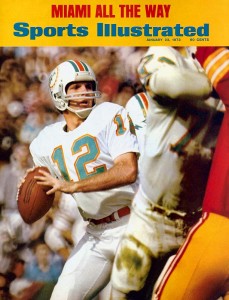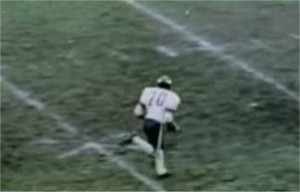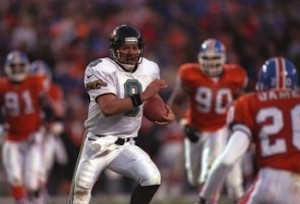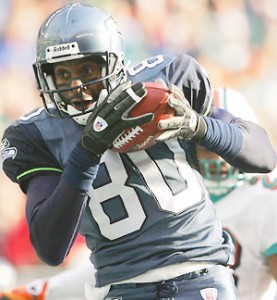Thirteen years ago, the Cleveland Browns were preparing for their return to the NFL. The Browns were the dominant team of the ’50s and were a consistent playoff contender for much of the ’60s and ’80s. In 1996, Art Modell took the Browns to Baltimore and renamed them the Ravens. Three years later, the NFL gave the city of Cleveland an expansion franchise; unfortunately, the new Browns have struggled to find an identity or a direction for much of their first thirteen seasons.
Consider: since 1999, the Browns have the second worst record in football, trailing only the Detroit Lions. Cleveland has scored the fewest points in the league and been outscored by the most points since returning to the NFL. [1]Excluding the Houston Texans, who entered the league in 2002. Still, the Browns have scored fewer points per game and been outscored by more points than the Texans. The Browns have been shutout 12 times, by far the most in the league over that span. The Browns and the Bills are the only teams to appear in only one playoff game since 1999, with neither team being victorious.
Symptomatic of the Browns’ failure to build a competitive team is the constant turnover at the most important positions. Assuming rookie Brandon Weeden starts in week one, he’ll be the 11th quarterback to start the season opener for the new Browns, and the sixth in six years. Pat Shurmur is Cleveland’s sixth head coach since returning to the league; Brad Childress is now their ninth offensive coordinator/play caller.
How do the Browns rank compared to other expansion teams? The Bears, Cardinals, Packers, Giants, Lions, Redskins, Steelers, Eagles and Rams all entered the league before 1940, making an apples-to-apples comparison impossible. The 49ers and Browns (v.1.0) entered the NFL from the All America Football Conference, so they weren’t expansion teams when they joined the NFL. The Baltimore Colts and their complicated history are probably best left off this list.
The AFL had eight founding members that played against each other, so none of them were true expansion teams. That leaves 11 other expansion teams in the modern era as benchmarks against whom we can rank the Cleveland Browns. Here’s how those other franchises performed in their first 13 seasons, with the obvious caveat that the Texans have only been around for a decade:
| Team | 1st Yr | Record | Win% | PPG | PPG Allowed | Playoff G | Playoff W | Div Titles | # of HCs | # of QBs |
|---|---|---|---|---|---|---|---|---|---|---|
| MIA | 1966 | 109-72-3 | 0.601 | 21.3 | 18.1 | 12 | 8 | 4 | 2 | 8 |
| DAL | 1960 | 98-76-6 | 0.561 | 23.9 | 20.5 | 13 | 7 | 5 | 1 | 7 |
| JAX | 1995 | 113-95-0 | 0.543 | 21.4 | 19.2 | 11 | 5 | 2 | 2 | 10 |
| MIN | 1961 | 94-81-7 | 0.536 | 21.7 | 19.7 | 9 | 4 | 5 | 2 | 8 |
| SEA | 1976 | 96-100-0 | 0.490 | 21.5 | 22.4 | 7 | 3 | 1 | 3 | 7 |
| CAR | 1995 | 97-111-0 | 0.466 | 19.7 | 20.3 | 9 | 6 | 3 | 3 | 11 |
| CIN | 1968 | 87-100-1 | 0.465 | 19.7 | 19.4 | 3 | 0 | 2 | 4 | 9 |
| HOU | 2002 | 65-95-0 | 0.406 | 20.1 | 23.1 | 2 | 1 | 1 | 2 | 7 |
| ATL | 1966 | 66-114-4 | 0.370 | 15.4 | 20.9 | 2 | 1 | 0 | 5 | 13 |
| CLE | 1999 | 68-140-0 | 0.327 | 16.2 | 22.2 | 1 | 0 | 0 | 6 | 16 |
| NOR | 1967 | 54-127-5 | 0.304 | 16.5 | 23.8 | 0 | 0 | 0 | 6 | 8 |
| TAM | 1976 | 57-138-1 | 0.293 | 16 | 22 | 4 | 1 | 2 | 3 | 17 |
Over the next two days, I’ll give some background and my ranking of the 12 expansion teams to enter the league since 1960, from best to worst, based on their first thirteen seasons in the league. Today, we’ll look at the best. Tomorrow, the bottom six.
#12 – Miami Dolphins (1966-1978)
The Dolphins trajectory highlights the importance of finding the right man for the job. Miami struggled through the last years of the AFL, going 15-39-2 in their first four years of existence. By 1969, the Dolphins already had Bob Griese, Larry Csonka, Mercury Morris, Jim Kiick and Larry Little on offense, along with Nick Buoniconti, Bill Stanfill, Manny Fernandez and Dick Anderson on defense. But playing under George Wilson, the long-time Lions coach, yielded little positive results.
In 1970, Don Shula — who cut his teeth as a defensive coordinator in Detroit in the early ’60s under Wilson — was hired away from the Baltimore Colts and took his talents to South Beach. Before coaching his first game, he traded for future Hall of Famer Paul Warfield, and then executed one of the greatest turnarounds in league history, taking the 3-10-1 Dolphins to a 10-4 record in his first season and earning a wild card berth. Miami made the Super Bowl the next season, and then in 1972 went undefeated en route to the franchise’s first Super Bowl title. Shula’s Dolphins repeated as champions in 1973, and could have pulled off a threepeat if not for Clarence Davis’ famous catch in Super Bowl VIII 1/2 in Oakland. Miami won at least 10 games (playing a 14-game schedule in all but one year) in eight of Shula’s first nine seasons; along with three Super Bowl appearances and two championships, that makes the Dolphins the most successful expansion franchise on our list.
#11 – Dallas Cowboys (1960-1972)
Dallas didn’t take very long to find the right men to lead the team: Owner/founder Clint Murchison, Jr. hired Tex Schramm to be the team’s general manager, and Schramm hired Tom Landry and Gil Brandt. The initial results weren’t good — the Cowboys went 0-11-1 in 1960 — but that was little fault of the men in charge. The team was created to rival Lamar Hunt’s Dallas Texans in the AFL, and the Cowboys weren’t officially part of the NFL until after the 1960 draft. The original team was made up almost exclusively of cast-offs from other franchises, and the Cowboys didn’t catch the rest of the league in talent for a few seasons.
By 1966, though, Dallas had fully matured. Over the next seven years, Dallas would lead the NFL in wins, playoff victories, and playoff games. The Cowboys lost in the NFL title game to the Packers in ’66 and ’67, both times with the outcome being decided in the final minute. In ’69, the Cowboys lost in the playoffs to the Browns, and continued to be known as “Next Year’s Champions.” In 1970, Dallas made their first Super Bowl appearance, only to lose to the Colts in perhaps the sloppiest Super Bowl of them all. Finally, the next year, under Roger Staubach, the Cowboys capitalized on their potential, winning their final 10 games to capture their first championship. After staging one of the most memorable playoff comebacks of all-time against the 49ers a year later, Dallas ran out of gas against the Redskins in the conference championship game.
Dallas ended up with a winning record in each of their last seven seasons (during the 13-year study). Add in a Super Bowl title and additional playoff success, and only the Dolphins had a better start.
#10 – Minnesota Vikings (1961-1973)
Like the Cowboys and Dolphins, immediate success eluded the Vikings. Coached by Norm Van Brocklin and quarterbacked by Fran Tarkenton, the Vikings could throw but do little else in the beginning. Minnesota allowed the most points in the NFL in three of their first five seasons, and after 1966, general manager Jim Finks turned to Bud Grant, who had been coaching in the CFL. Carl Eller, Jim Marshall and Gary Larsen had already been on team, but Grant selected Alan Page with the 15th pick in the ’67 draft. The next year, Vikings drafted Ron Yary first overall and the core of the team was complete: from 1968 to 1973, only the Dallas Cowboys won more games. From 1969 to 1971, Minnesota sported arguably the best statistical defense in league history, leading the league in points allowed each year and finishing 1st, 1st and 2nd in yards allowed.
Minnesota’s elite defense helped the franchise win the NFL title game in 1969 before getting upset by the Chiefs in the Super Bowl. After playoff losses in each of the next two seasons, Minnesota reacquired Fran Tarkenton and continued to be one of the top teams in the league for the remainder of the decade. In 1973, 1974 and 1976, the Vikings lost on the biggest stage to different AFC powerhouses, in increasingly embarrassing fashion. It took seven years, but the Vikings eventually built one of the best teams to never win a Super Bowl. While technically outside the scope of the 13-year period, no other franchise has ever appeared in four Super Bowls as quickly (16 years) as the Vikings.
#9 Jacksonville Jaguars (1995-2007);
#8 Carolina Panthers (1995-2007)
The Jaguars and Panthers entered the NFL together and it’s hard to ignore the similarities between how the two franchises evolved. The teams filled the large, previously empty area of the country best defined as SEC country: on the East Coast, there were no teams south of Washington and north of Tampa Bay. The Jaguars traded for Green Bay’s Mark Brunell and selected LT Tony Boselli with the second pick in the draft; the Panthers signed Sam Mills to lead the defense and traded down from the first to the fifth pick to select Kerry Collins. Under Dom Capers, Carolina’s defense was good immediately, ranking in the top eight in points allowed, yards allowed, yards per pass allowed and yards per rush allowed. The next year, Carolina went 12-4 and ranked 2nd in points allowed. Tom Coughlin’s Jaguars took a little longer to get ready, but had Mark Brunell, James Stewart and Jimmy Smith from their first game. After a 4-12 inaugural season, the Jaguars sneaked into the playoffs in 1996, as Mark Brunell made the Pro Bowl and both Jimmy Smith and newly acquired Keenan McCardell topped 80 catches and 1100 yards. Both Jacksonville and Carolina reached the conference title game, before ultimately losing in New England and Green Bay, respectively.
The fates of the franchises went in different directions from there. Kerry Collins and the offense imploded in ’97, and Collins’ off-the-field issues led to his dismissal from the team in ’98. Capers was gone after the season and replaced by George Seifert, who — save an incredibly exciting last seven weeks of the ’99 season [2]Over the last seven weeks of the year, Steve Beuerlein turned into Johnny Unitas, throwing for 2,053 yards, 22 TDs and 3 interceptions. His favorite target was Patrick Jeffers, who gained 782 yards … Continue reading — had a largely forgettable, three-year tenure in Carolina. In his final year, Carolina plummeted to 1-15. In 2002, new coach John Fox used the 2nd pick in the draft to select Julius Peppers and revamp the once great defense; within two years, the Panthers were in their first and only Super Bowl.
Meanwhile, the Jaguars were able to keep their momentum going after their 1997 season. Jacksonville went 11-5 each of the next two seasons, winning the division in 1998. In ’99, the Jaguars peaked, going 15-0 against the rest of the NFL, but 0-3 against the Tennessee Titans. Their defense — now being run by Capers — led the league in points allowed, while the offense was lethally balanced. Jacksonville ranked in the top three in rushing yards and yards per carry, but also boasted an excellent aerial assault thanks to Mark Brunell and Jimmy Smith (116 catches, 1,636 yards and 6 TDs). The Jaguars followed up their magnificent 1999 with three losing seasons, ultimately costing Tom Coughlin his job.
In 2003 — the year the Panthers made the Super Bowl — Jack Del Rio took over and began the most nondescript eight-and-a-half-year reign in football history. The Jaguars were usually solid under Del Rio and almost always strong defensively; he was fired last year with a career 73-63 record. The ’03 Panthers were one of the least impressive teams to make a Super Bowl, but still almost dethroned the Patriots and were part of one of the most exciting fourth quarters in Super Bowl history. Fox then unsuccessfully spent the next six seasons trying to figure out how to make Jake Delhomme repeat his play from that night.
Over their first 13 seasons, Carolina only made the playoffs three times. Their Super Bowl appearance bumps them up, but not above a Jacksonville team that won more than half of their games and made six playoff trips.
#7 Seattle Seahawks (1976-1988)
The Seahawks lost before they ever took the field. Seattle joined the league in 1976, along with Tampa Bay, and lost the coin toss for the first overall selection to the Buccaneers. Tampa Bay selected future Hall of Famer Lee Roy Selmon. In what had been perceived as a two-person draft, the Seahawks used the 2nd pick on the draft’s third best prospect: Notre Dame’s Steve Niehaus. Seattle used 14 minutes and 58 seconds of their allotted time, and finally chose Niehaus over California running back Chuck Muncie. Niehaus won NFC Defensive Rookie of the Year in 1976, but injuries ruined his career: he was out of the NFL four years later. Seattle didn’t have any luck drafting future stars in 1976, but they did add two excellent rookies — following pit stops in Texas — in other ways.
Jim Zorn was an undrafted free agent who was cut by the Cowboys in training camp in 1975, but wound up starting every game for the Seahawks in their first season. Steve Largent was drafted by the Houston Oilers in the fourth round of the 1976 draft, but was nearly cut before the season started. The Seahawks sent an 8th round pick to Houston in exchange for Largent, who would wind up retiring as the all-time NFL leader in receptions, receiving yards and receiving touchdowns when he retired. Thanks to Zorn and Largent, Seattle was able to become competitive faster than most expansion teams. After a 2-12 initial season, the Seahawks led the league in passing touchdowns in 1977, and ranked 8th in both points and passing yards. The Seahawks had excellent offenses in ’78 and ’79, but weak defenses left Seattle with 9-7 records both years.
But that was as far as Jack Patera would take Seattle: the team regressed in ’80 and ’81, and Patera was fired during the 1982 strike. In 1983, Chuck Knox came to Seattle and the franchise’s fortunes changed: Seattle did not have a losing record again until 1989. In 1983, the Seahawks made the playoffs for the first time, and defeated the Broncos and Dolphins, each led by rookie, Hall of Fame quarterbacks. But despite sweeping the Raiders in the regular season, the Seahawks were embarrassed in Los Angeles in the AFC Championship Game. Seattle started the ’84 season 12-2, and even avenged their loss to the Raiders by winning 13-7 in the wild card round of the playoffs. But by then a more mature Dan Marino was at his best, and the Seahawks season ended in the Orange Bowl. Seattle would again make the playoffs in ’87 and ’88, but lost in the first round both seasons.
In their first 13 seasons, the Seahawks won 49% of their games, made the playoffs four times, and won the division once. As far as expansion teams go, that’s not half-bad.
Tomorrow, we’ll take a look at the six worst expansion teams of the modern era.
References
| ↑1 | Excluding the Houston Texans, who entered the league in 2002. Still, the Browns have scored fewer points per game and been outscored by more points than the Texans. |
|---|---|
| ↑2 | Over the last seven weeks of the year, Steve Beuerlein turned into Johnny Unitas, throwing for 2,053 yards, 22 TDs and 3 interceptions. His favorite target was Patrick Jeffers, who gained 782 yards and 9 touchdowns. Carolina scored 225 points — one point behind the Greatest Show on Turf Rams — for an average of 32.1 points per game. In Seifert’s 41 other games in Carolina, the Panthers averaged just 18.5 points per game. |




